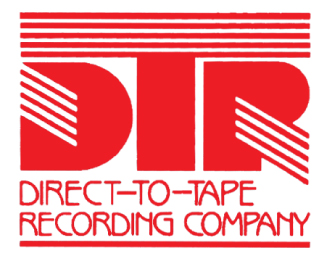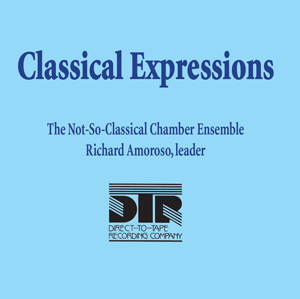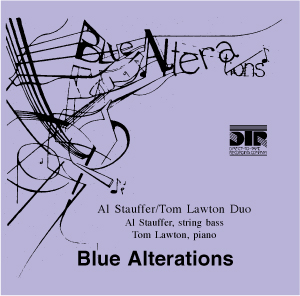You are reading the older HTML site
Positive Feedback ISSUE 70
The Direct-To-Tape
Recording Company is Back and Other New Surprises at HDTT
The Direct-to-Tape Recording Company (DTR) was founded in 1979 with the goal of capturing the sound of a performance as one would hear it if one were there. DTR recordings used no editing within each movement or piece in order to capture the musical soul of a performance, they were the tape equivalent of the Direct-to-Disc LP which was popular at the time. They were usually recorded with two microphones to capture a natural sound and the acoustic space of the performance. They used no equalization, compression, or limiting. DTR recorded mostly classical and jazz which are well served by their minimalist recording techniques. They captured the ensemble of the instruments, the room acoustics, and the integration of the room acoustics with the sounds of the instruments. This resulted in recordings that sound very close to what one would have heard at a live performance. All of this requires greater skill from the performers. Back in the halcyon days of consumer analog tape formats DTR offered their recordings on real time (1:1) custom duplicated 2 and 4-track reel to reels at 15 and 7˝ IPS using Agfa mastering tape, and on real time (1:1) custom duplicated cassettes. These reissued high resolution downloads are from the actual 15 IPS 2-track master tapes with the cooperation and permission of DTR Recordings. I reviewed the Direct-To-Tape recordings in HDTT's DSD128 (5.6MHz) versions.
Richard Amoroso conducting the Not-So-Classical Chamber Ensemble, Classical Expressions "Sabre Dance," "Nostalgia," "Whirlwind," "Orientale - Spanish Dance No. 2," "Zapateado," "Prelude in G," "Piece in the Form of a Habanera," "The Bee," "Prelude II," "Flight of the Bumble Bee," "The Girl with Flaxen Hair," "Tico Tico" Recorded August and September 1981. Producer and Engineer: Bob Sellman. Transferred from the 15 IPS 2-track master tapes. HDDLDTR1. Available Formats: Compact Disc, HQCD (High Quality Compact Disc), 24bit 96kHz DVD, 24bit 192kHz DVD-Audio, 24bit 96kHz FLAC download, 24bit 192kHz FLAC download, DSD64 (2.8MHz) download, DSD128 (5.6MHz) download. https://www.highdeftapetransfers.com/product.php?pid=7349 The Not-So-Classical Chamber Ensemble was formed by Richard Amoroso in 1979. The Ensemble concentrates primarily on light Romantic popular music, with particular emphasis on Spanish music. Richard Amoroso is the leader, chief arranger, and cellist for the group. Other members of the ensemble on this recording include Ronald Amoroso (classical accordion), Patrick and Regecca Mercuri (mandolin and guitars), Walter Pfeil (harp), Nick Mastripolito (piano), Nick D'Amico (marimba), John Leitham (string bass), and Harvey Price (percussion). This recording was made using two Schoeps microphones, and as noted above, direct to 2-track 15 IPS analog tape with no splices or edits within any songs and no compression, equalization or limiting. The DSD versions of this recording were transferred straight from the analog reel to reel tape to a DSD analog to digital converter with no PCM conversion for editing or processing. I reviewed the DSD128 (5.6MHz) version. Khachaturian's "Sabre Dance" from his ballet Gayne begins this unusual classical flavored program; it's arranged for this small ensemble with percussion. I found this version quite exciting, and it conveys the savage rhythms quite effectively. Next is "Nostalgia," played by two guitarists only, it's a relatively unknown piece which was originally composed by Eloysa Barroso for solo piano, and later arranged by Laurindo Almeida for two guitars. "Whirlwind" for solo harp, is one of five poetic preludes by Carlos Slazedo, and takes advantage of the harp's wide dynamic range. "Orientale - Spanish Dance No. 2" by Enrique Granados is from his Spanish Dances for solo piano, which is performed here in an arrangement for classical accordion and cello. It combines melodic and rhythmic charm with tasteful elegance in its treatment of folk tunes. Pablo de Sarasate's "Zapateado" is arranged for cello, harp, accordion, and piano. Rachmaninoff's "Prelude in G" is arranged here by Ron Amoroso for cello, harp, and accordion. Ravel originally composed the "Piece in the Form of a Habanera" as a wordless song for voice and piano, later transcribed for violin and piano, which is the best known version. The transcription here is for cello and harp. "The Bee," originally composed for violin and piano by Franz Schubert, and later transcribed for cello and piano by Pablo Casals, is presented here on cello and accordion. "Prelude No. 2" is the second of Gershwin's three blues influenced preludes for solo piano, here transcribed by Pat Mercuri for cello and guitar. The "Flight of the Bumble Bee" is from Rimsky-Korsakoff's opera "Tsar Sultan," acknowledged by virtually every musician to be one of the most difficult pieces to play. Debussy originally wrote "The Girl with Flaxen Hair" as a prelude for solo piano, this arrangement is for cello and accordion. The last piece "Tico Tico" composed by Zequinha, is a popular classic written in a Latin American style, and one of my favorite selections on this recording due to the large variety of colorful percussion. The first and last works are my favorites; the album is musically enjoyable and is an unusual ensemble for classical music. The sonics are just about perfect.
Al Stauffer / Tom Lawton Duo, Blue Alterations "Blue Alterations," "Yestermorrow," "In Time Past," "Tired Blues," "Melody". Recorded May 31, 1981 at Wilson Music Hall, Glassboro State College (now Rowan University), New Jersey. Producer and Engineer: Bob Sellman. Transferred from the 15 IPS 2-track master tape. HDDLDTR2 Available Formats: Compact Disc. HQCD (High Quality Compact Disc), 24bit 96kHz DVD, 24bit 192kHz DVD-Audio, 24bit 96kHz FLAC download, 24bit 192kHz FLAC download, DSD64 (2.8MHz) download, DSD128 (5.6MHz) download. http://www.highdeftapetransfers.com/product.php?pid=7416 Al Stauffer / Tom Lawton Duo consists of Al Stauffer on string bass and Tom Lawton on piano. Each piece was recorded as a complete performance and contains no splices or editing. The recording was made using two Schoeps mics placed at a distance from the performing group to capture the sound of the group as you would hear it in a true acoustic performance with no amplification. The DSD versions of this recording were transferred straight from the analog reel to reel tape to a DSD analog to digital converter with no PCM conversion for editing or processing. I reviewed the DSD128 (5.6MHz) version. Stauffer was one of the Philadelphia area's most esteemed jazz bassists, he has accompanied such prime jazzmen as Stan Getz, Zoot Sims, Al Cohn, Gerry Mulligan, Bill Evansk, and Sam Most, and his association with Bernard Peiffer lasted a dozen years. He duets with himself by vocalizing in unison with his bass during solos much like Major Holley and others have. Tom Lawton, a native of Collegeville, Pennsylvania, came to jazz after 12 years of classical training. Upon hearing pianist Gerald Price he became interested in jazz and began studying it. This is modern jazz with a blues flare and nice jazzy rhythms despite the lack of a drummer. The title piece, "Blue Alterations," is swinging blues. "Yestermorrow" is slower and more flowing. "In Time Past" begins as a slow sad melancholy piece with the bass increasing in acceleration as the piece progresses making quite an interesting contrast between the piano, bass, and the bassist's vocalizations. "Tired Blues" is misnamed, it should have been named something more like "Relaxed Blues" as composer Bernard Peiffer had some difficulty with communicating in English. The final piece is a jazzed up "Melody" of works by classical composer Aram Khachaturian. The sound is so real, it's like having the piano, bass, and the bassist's wordless vocalizing in my room making it a nice jazz experience. I recommend both of these downloads for both the sonics and the musical experiences, even though I generally prefer more percussion, that is coming in my next HDTT review "Percussion in Hi-Fi". There are now 5 DTR titles available from HDTT the others are: A Feast of Carols, Heroic Music for Baroque Trumpet and Organ, and Kodály: Laudes Organi see: http://www.highdeftapetransfers.com/page.php?wid=30 Other new items at HDTT Three Albany classical releases from the original 24 bit digital masters and David Elias' DSD folk recordings. Upcoming soon is HDTT's first 24/96 multichannel recording which will be available as 2-channel and 5-channel downloads and on a BluRay disc. http://www.highdeftapetransfers.com
|




